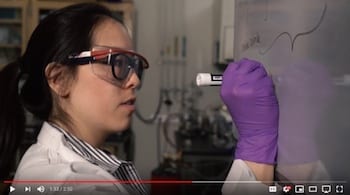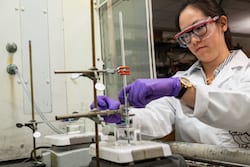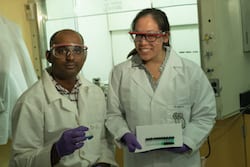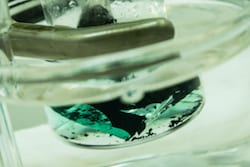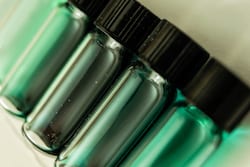NEWS RELEASE
Editor’s note: Links to video and high-resolution images for download appear at the end of this release.
David Ruth
713-348-6327
david@rice.edu
Mike Williams
713-348-6728
mikewilliams@rice.edu
New ‘blue-green’ solution for recycling world’s batteries
Rice scientists show solvent leaches cobalt, lithium for reuse from spent batteries
HOUSTON – (April 1, 2019) – Rice University researchers literally have a solution to deal with the glut of used lithium-ion batteries left behind by the ever-increasing demand for electric vehicles, cellphones and other electronic devices.
The Rice lab of materials scientist Pulickel Ajayan used an environmentally friendly deep eutectic solvent to extract valuable elements from the metal oxides commonly used as cathodes in lithium-ion batteries. The goal, researchers said, is to curtail the use of harsh processes to recycle batteries and keep them out of landfills.
The solvent, made of commodity products choline chloride and ethylene glycol, extracted more than 90 percent of cobalt from powdered compounds, and a smaller but still significant amount from used batteries.
“Rechargeable battery waste, particularly from lithium-ion batteries, will become an increasingly menacing environmental challenge in the future as the demand for these through their usage in electric vehicles and other gadgets increases dramatically,” Ajayan said.
“It’s important to recover strategic metals like cobalt that are limited in supply and are critical for the performance of these energy-storage devices,” he said. “Something to learn from our present situation with plastics is that it is the right time to have a comprehensive strategy for recycling the growing volume of battery waste.”
The results appear in Nature Energy.
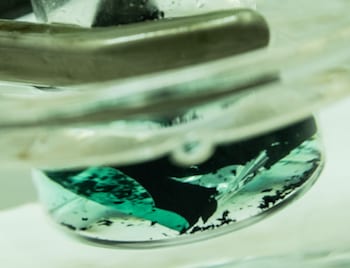
A solution turns green as it pulls cobalt from a spent lithium-ion cathode. A Rice University laboratory is developing an environmentally friendly method to recover valuable metals from used batteries. Photo by Jeff Fitlow
“This has been attempted before with acids,” said Rice graduate student and lead author Kimmai Tran. “They’re effective, but they’re corrosive and not eco-friendly. As a whole, recycling lithium-ion batteries is typically expensive and a risk to workers.”
Other processes also have drawbacks, she said. Pyrometallurgy involves crushing and mixing at extreme temperatures, and the harmful fumes require scrubbing. Hydrometallurgy requires caustic chemicals, while other “green” solvents that extract metal ions often require additional agents or high-temperature processes to fully capture them.
“The nice thing about this deep eutectic solvent is that it can dissolve a wide variety of metal oxides,” Tran said. “It’s literally made of a chicken feed additive and a common plastic precursor that, when mixed together at room temperature, form a clear, relatively nontoxic solution that has effective solvating properties.”
A deep eutectic solvent is a mixture of two or more compounds that freezes at temperatures much lower than each of its precursors. In that way, she said, one can literally obtain a liquid from a simple combination of solids.
“The large depression of freezing and melting points is due to the hydrogen bonds formed between the different chemicals,” Tran said. “By selecting the right precursors, inexpensive ‘green’ solvents with interesting properties can be fabricated.”
When Tran joined, the Rice group was already testing a eutectic solution as an electrolyte in next-generation high-temperature supercapacitors.
“We tried to use it in metal oxide supercapacitors, and it was dissolving them,” said Rice research scientist and co-corresponding author Babu Ganguli. “The color of the solution would change.”
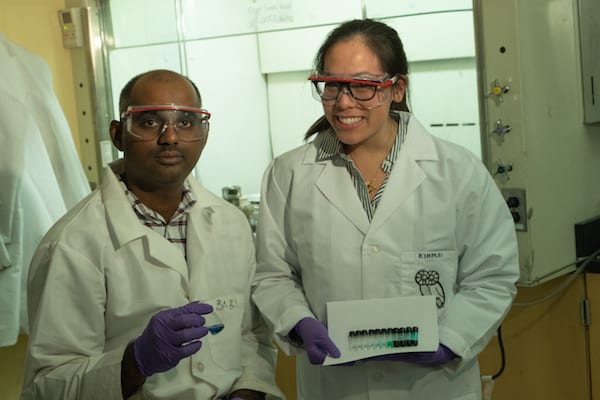
Rice University research scientist Babu Ganguli and graduate student Kimmai Tran show test tubes with their eutectic solvent and varying concentrations of cobalt drawn into the solution. They are developing the solvent to extract cobalt and lithium from spent lithium-ion batteries. Photo by Jeff Fitlow
The eutectic was pulling ions from the supercapacitor’s nickel.
“Our team was discussing this and we soon realized we could use what was thought to be a disadvantage for electrolyte as an advantage for dissolving and recycling spent lithium batteries,” Ganguli said.
That became Tran’s focus, as she tested deep eutectic solvents on metal oxides at different temperatures and time scales. During tests with lithium cobalt oxide powder, the clear solvent yielded a wide spectrum of blue-green colors that indicated the presence of cobalt dissolved within.
At 180 degrees Celsius (356 degrees Fahrenheit), the solvent extracted nearly 90 percent of lithium ions, and up to 99 percent of cobalt ions from the powder when certain conditions were satisfied.
The researchers built small prototype batteries and cycled them 300 times before exposing the electrodes to the same conditions. The solvent proved adept at dissolving the cobalt and lithium while separating the metal oxides from the other compounds present in the electrode.
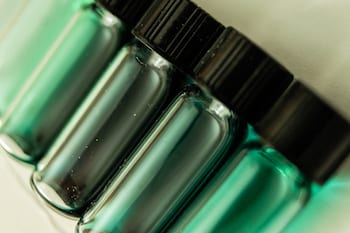
The blue-green color of solutions reveals the presence of cobalt taken from spent lithium-ion batteries through a new process developed at Rice University. Photo by Jeff Fitlow
They found that cobalt could be recovered from the eutectic solution through precipitation or even electroplating to a steel mesh, as this latter method potentially allowed for the deep eutectic solvent itself to be reused.
“We focused on cobalt,” said Rice alumnus Marco Rodrigues, now a postdoctoral researcher at Argonne National Laboratory. “From a resource standpoint, it’s the most critical part. The battery in your phone will surely have lots of it. Lithium is very valuable too, but cobalt in particular is not only environmentally scarce but also, from a social standpoint, hard to get.”
He noted the Department of Energy is mounting new efforts to advance battery recycling technologies and recently announced a center for Li-ion battery recycling.
The path forward will require continued efforts.
“It’s likely we won’t be able to recycle and replace mining completely,” Tran said. “These technologies are relatively new, and there is a lot of optimization that needs to be done, such as exploring other deep eutectic solvents, but we truly believe in the potential for greener ways to do dirty chemistry. Sustainability is in the heart of the work I do and what I want to do for the rest of my career.”
Graduate student Keiko Kato is a co-author of the paper. Ajayan is the Benjamin M. and Mary Greenwood Anderson Professor in Engineering and a professor of chemistry.
The National Science Foundation supported the research through its Graduate Research Fellowship Program.
-30-
Read the abstract at https://doi.org/10.1038/s41560-019-0368-4.
Follow Rice News and Media Relations via Twitter @RiceUNews.
Related materials:
Ajayan Research Group: http://ajayan.rice.edu
Department of Materials Science and NanoEngineering: https://msne.rice.edu
George R. Brown School of Engineering: https://engineering.rice.edu
Video:
Video produced by Brandon Martin/Rice University
Images for download:
https://news2.rice.edu/files/2019/03/0325_RECYCLING-1-web-1r7wsfm.jpg
Rice University graduate student Kimmai Tran and her colleagues have developed an environmentally friendly solution to remove valuable cobalt and lithium metals from spent lithium-ion batteries. (Photo by Jeff Fitlow/Rice University)
https://news2.rice.edu/files/2019/03/0325_RECYCLING-2-web-26lrxdm.jpg
Rice University research scientist Babu Ganguliand graduate student Kimmai Tran show test tubes with their eutectic solvent and varying concentrations of cobalt drawn into the solution. They are developing the solvent to extract cobalt and lithium from spent lithium-ion batteries. (Photo by Jeff Fitlow/Rice University)
https://news2.rice.edu/files/2019/03/0325_RECYCLING-3-web-20t2b9c.jpg
A solution turns green as it pulls cobalt from a spent lithium-ion cathode. A Rice University laboratory is developing an environmentally friendly method to recover valuable metals from used batteries. (Photo by Jeff Fitlow/Rice University)
https://news2.rice.edu/files/2019/03/0325_RECYCLING-4-web-2ard3y3.jpg
The blue-green color of solutions reveals the presence of cobalt taken from spent lithium-ion batteries through a new process developed at Rice University. (Photo by Jeff Fitlow/Rice University)
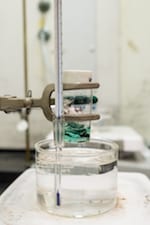
https://news2.rice.edu/files/2019/03/0325_RECYCLING-5-web-2eeqpyz.jpg
Experiments at Rice University have led to the development of an environmentally friendly process to recover valuable cobalt and lithium metals from spent batteries. (Photo by Jeff Fitlow/Rice University)
Located on a 300-acre forested campus in Houston, Rice University is consistently ranked among the nation’s top 20 universities by U.S. News & World Report. Rice has highly respected schools of Architecture, Business, Continuing Studies, Engineering, Humanities, Music, Natural Sciences and Social Sciences and is home to the Baker Institute for Public Policy. With 3,962 undergraduates and 3,027 graduate students, Rice’s undergraduate student-to-faculty ratio is just under 6-to-1. Its residential college system builds close-knit communities and lifelong friendships, just one reason why Rice is ranked No. 1 for lots of race/class interaction and No. 2 for quality of life by the Princeton Review. Rice is also rated as a best value among private universities by Kiplinger’s Personal Finance.
